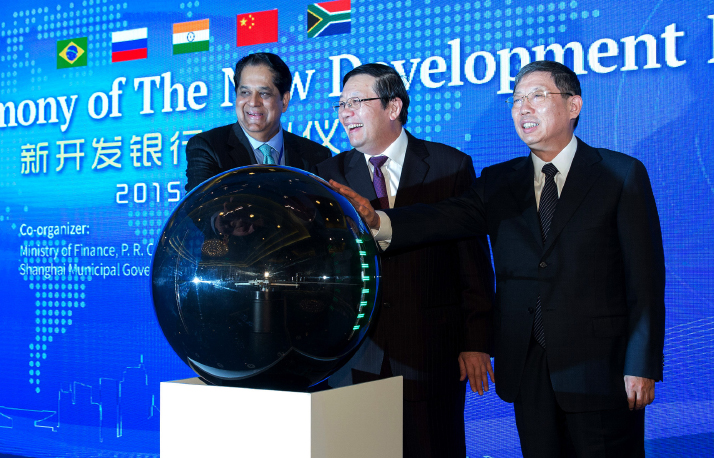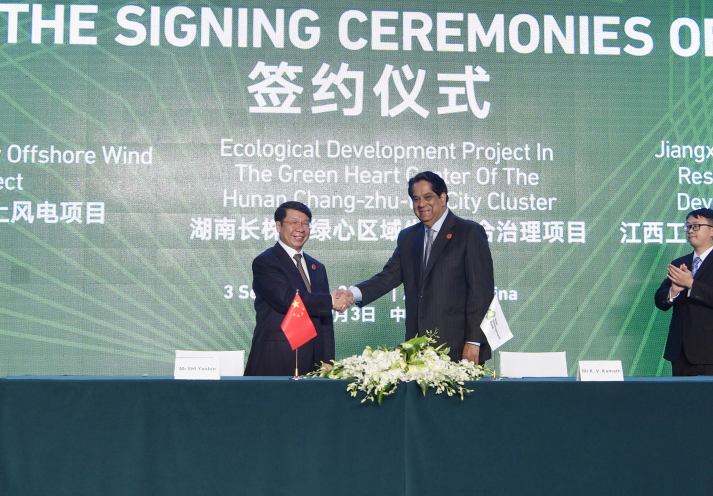|
||||||
|
||||||
| Home Nation World Business Opinion Lifestyle China Focus ChinAfrica Video Multimedia Columnists Documents Special Reports |
|
||||||
|
||||||
| Home Nation World Business Opinion Lifestyle China Focus ChinAfrica Video Multimedia Columnists Documents Special Reports |
| President Xi Visits Arab and African Countries, Attends BRICS Summit > South Africa |
| Financing Muscle |
| The BRICS New Development Bank plays a major role in assisting Africa to realize independent and sustainable growth |
| By Hou Weili · 2018-07-13 · Source: | ChinAfrica |
Issuing its first green bond in China, getting a AAA rating from Chinese lending agencies and setting up its first regional office, the Africa Regional Center (ARC) in Johannesburg. These are some of the major breakthroughs achieved by the New Development Bank (NDB), a BRICS-initiated multilateral development bank, in the last three years.
This July sees both the third anniversary of the establishment of the NDB and the hosting of the 10th BRICS Summit in Johannesburg, South Africa. The NDB's achievements are part of its vision of mobilizing resources for infrastructure and sustainable development in BRICS members and emerging economies as a whole.  Lou Jiwei (center), then Minister of Finance of China, Yang Xiong (right), then Mayor of Shanghai and K. V. Kamath, President of NDB witness the launch of the bank in Shanghai on July 21, 2015 (ZHANG CHUNHAI)
According to NDB Vice President Leslie Maasdorp, the bank has approved loans of $5.1 billion since its inception, used on 16 projects. "All of these projects focused on improving sustainability and addressed some of the critical development needs of our member countries," said K.V. Kamath, President of NDB at the opening ceremony of the bank's Third Annual Meeting held in Shanghai late May. Among the projects underway, one is based in South Africa. It is a $180-million renewable energy transmission project carried out by Eskom, the largest electricity producer in Africa. The sovereign guaranteed project is expected to reduce carbon dioxide emission by 1.3 million tons annually. NDB has grand ambitions for 2018. According to its 2018 budget summary, the bank plans to approve up to 20 new projects estimated at $4 billion through a mixture of issuances in U.S. dollars and local currencies, and will begin its private sector lending operations while also considering a second regional office in Brazil. In the first half of 2018, the approved projects aggregate was over $1.7 billion. Maasdorp said the bank is planning to reach $15 billion worth of loans by 2021. While being committed to its vision, the NDB is embracing more members and adapting to emerging technologies to optimize the investment for sustainability.  Shi Yaobin (left), then Vice Minister of Finance, shakes hands with K. V. Kamath, President of NDB after NDB signed three loan agreements with Chinese companies in Xiamen on September 3, 2017 (JIN LIANGKUAI)
Smart infrastructure Infrastructure is still a major constraint to boost the economy in many emerging and developing countries. As the technology advances, "the infrastructure that we need to build today, for use over the next several decades, is fundamentally different from what we built in the past," Kamath noted. In China, for example, bike-sharing technology is encouraging more people to take public transportation as it provides a last-km solution. Autonomous vehicle technologies are also evolving and governments are encouraging tests of such technology. "This will fundamentally change the way roads, bridges and parking systems are designed and built," said Kamath. Besides, smart grids, green buildings, hyperloops and underground roadways have the potential to advance rapidly in conjunction with the ongoing innovations in network connectivity and bandwidth. The NDB is conscious of these and other ongoing developments and aligns its investment decisions to the new pattern of transportation. "The biggest economic opportunity today is that we can invest in a new generation of smart and sustainable technologies to meet our infrastructure requirements," said Kamath. Scaling up finances The NDB brought much good news to Africa this year. At its Third Annual Meeting, South African Finance Minister Nhlanhla Nene was elected as the chairman of the board of governors of NDB. It was also decided that the next annual meeting will be held in South Africa in 2019. The scale and scope of the ARC will be further increased. These decisions indicate further financial support given to the African continent, and commitment to boost development in Africa under the framework of BRICS cooperation, said Huang Yupei, an expert in China-Africa economic cooperation at the China-Africa International Business School of Zhejiang Normal University. "The NDB adopts an effective approach to facilitate regional integration, industrialization and infrastructure construction in Africa by lending to specific projects," said Huang. Opened for business last year, the ARC is initially tasked with project identification and preparation and serves as the NDB's interface for governments, entities from the private sector, financial institutions and project preparation agencies. With the ARC's active role, the NDB signed a memorandum of understanding on general cooperation with the Development Bank of Southern Africa (DBSA), formalizing a framework of cooperation between the NDB and African regional financial institutions for the common interest of fostering sustainable development. A South African state-owned development bank, the DBSA, works across the continent to promote economic and social development, as well as regional integration through infrastructure investment and development. "Such cooperation will assist Africa to realize independent and sustainable development," said Huang. The ARC is taking an innovative approach to lending models, including local currency financing and attracting the private sector to contribute funds. It is not able to make up the entire financial gap, but "will boost investors' confidence on infrastructure and sustainable development projects, which requires heavy investment and a long period to reward and accelerate lending to sectors such as energy, transportation, water supply and irrigation system," said Huang.  Chinese companies have been supporting African countries in developing renewable energy, engaging in solar, hydro, wind and thermal projects (XINHUA)
In many cases, while it appears that infrastructure construction projects are in short of funds, the challenge is actually a lack of market and credit rules and systems to bring in funds and foster sustainable growth, according to insiders. Development multilateral institutions like the NDB can help boost investors' confidence by effectively combining government credit and market-oriented operations and stimulating investment in long-term projects. A unique way in which it differs from other development banks, the NDB offers loans in local currencies. "This means that the recipient countries could better avoid the risks of the exchange rate fluctuations, and focus on long-term sustainable projects," Huang explained. Loans by the NDB are not restricted to BRICS member countries as it has been an open multilateral financing platform from the inception. The bank is now making preparations in terms of acceptance procedures and technical details to absorb non-BRICS countries and enlarge the circle of friends. "With increased global influence and more funds raised and contributed, the NDB will include more African countries in its financial support scheme. The upcoming BRICS Summit is expected to materialize more tangible benefits in this regard, and set out routes to upgrade financial cooperation," said Huang. (Comments to houweili@chinafrica.cn) |
About Us | Contact Us | Advertise with Us | Subscribe
|
||
| Copyright Beijing Review All rights reserved 京ICP备08005356号 京公网安备110102005860号 |